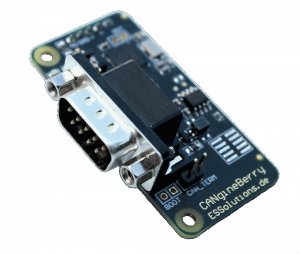 NXP and EmSA are inviting you to the one hour seminar “Accelerate Development of Robust Network Communications with CANopen and CANopen FD” on Tuesday April 21st 2020. This webinar is a hands-on session about customized CANopen (FD) development on NXP MCUs.
NXP and EmSA are inviting you to the one hour seminar “Accelerate Development of Robust Network Communications with CANopen and CANopen FD” on Tuesday April 21st 2020. This webinar is a hands-on session about customized CANopen (FD) development on NXP MCUs.
In the hands-on part, we take the CANopen (FD) device/slave example included with the NXP MCUXpresso SDK and use the free CANopen Architect Mini software utility to modify and configure the CANopen (FD) communication of the device. Code modifications are made using the MCUXpresso SDK to support the custom generated CANopen (FD) object dictionary entries. Click here to register for this webinar.
The webinar requires some basic CANopen (FD) and MCUXpresso knowledge. See our courses at www.em-sa.com/video to learn the basics about these technologies.
 The new CANgineBerry is an active CAN interface with a Cortex-M0 microcontroller and various firmware options. At launch, two options are available: One for a CANopen Controller / Manager and one for a configurable CANopen slave device.
The new CANgineBerry is an active CAN interface with a Cortex-M0 microcontroller and various firmware options. At launch, two options are available: One for a CANopen Controller / Manager and one for a configurable CANopen slave device.
The CANopen Controller scans the network for connected slave devices within less than 50 ms after power-up, sets up process data handling, starts the network and continues monitoring it. Once the host that CANgineBerry is connected to is up and running as well, it can immediately start using the CANopen network and access any device.
The second firmware option is implementing a CANopen slave device which is fully configurable with node ID and with an Object Dictionary that the user creates with the provided CANopen Architect software (evaluation version is sufficient for this use).
The CANgineBerry’s host can be a Raspberry Pi®, another embedded computing systems or even a PC. The communication to the host system uses a regular serial channel (TTL-UART), so no special driver is required as UART support is typically part of all operating systems. The communication between host and CANgineBerry and the API is designed to serve the application. For example, heartbeats are automatically monitored but the host is only informed about changes in the heartbeat status (like “activated” or “lost”) but not about every individual heartbeat message.
This architecture of CANgineBerry addresses the shortcomings of many “CAN shields” that are passive, have no own intelligence and require the host computer to handle all CAN communication message by message. In worst case, a CAN system can have more than ten thousand individual messages per second. Sometimes the real-time requirements are below 10 ms for some responses which is not realistically achievable with a Linux or Windows® based host and a passive approach.
Summary of firmware options currently available or under development:
- CANopen self-configuring Controller / Manager
- CANopen slave device (configurable via EDS, Electronic Data Sheet)
- Lawicel CAN-RS232 protocol
- CANcrypt (secure CAN communication) for the above versions
- CiA 447 – automotive add-on electronics
- J1939 gateway
For more information about the CANgineBerry, current firmware options and availability, visit www.CANgineBerry.com
We have released a new version of CANopen Architect, aimed at advanced users. The new Professional version builds upon the features found in the Standard version adding new functionality for quicker data entry and ideal for developers of CANopen products.
The Professional version can export Electronic Data Sheets as Word documents, allowing automatic generation of product manuals and internal documentation. Enter a descriptive text for each entry, choose the export options and save. The output can be used as a standalone manual or can be copied and pasted into an existing manual. Options are provided for using a template document and styling headings and tables.
A user-friendly PDO configuration window has been added. The new window allows quick and easy PDO creating and editing at a higher level than Object Dictionary entries. Mappings can be changed and reviewed without worrying about needing to keep the various underlying Object Dictionary entries consistent. Users of our CANopen Magic configuration and analysis tool will find the new window immediately familiar.
The new version provides an integrated command line interface allowing power users to quickly create and manipulate large amounts of PDOs. Commands can be placed into files and executed in a single step. Multiple commands for a variety of situations are provided and will be added to from time to time.
For details of the new features and to try the evaluation version please visit the CANopen Architect website.
Existing users of CANopen Magic Standard are able to upgrade. Please contact us for pricing.
 NXP and EmSA are inviting you to the one hour seminar “Accelerate Development of Robust Network Communications with CANopen and CANopen FD” on Tuesday April 21st 2020. This webinar is a hands-on session about customized CANopen (FD) development on NXP MCUs.
NXP and EmSA are inviting you to the one hour seminar “Accelerate Development of Robust Network Communications with CANopen and CANopen FD” on Tuesday April 21st 2020. This webinar is a hands-on session about customized CANopen (FD) development on NXP MCUs. Deutsch
Deutsch English
English


 Learn about our current product range for embedded systems
Learn about our current product range for embedded systems


 Embedded Networking with CAN and CANopen. Your technology guide for implementing CANopen devices.
Embedded Networking with CAN and CANopen. Your technology guide for implementing CANopen devices. Implementing scalable CAN security. Authentication and encryption for higher layer protocols, CAN and CAN-FD
Implementing scalable CAN security. Authentication and encryption for higher layer protocols, CAN and CAN-FD